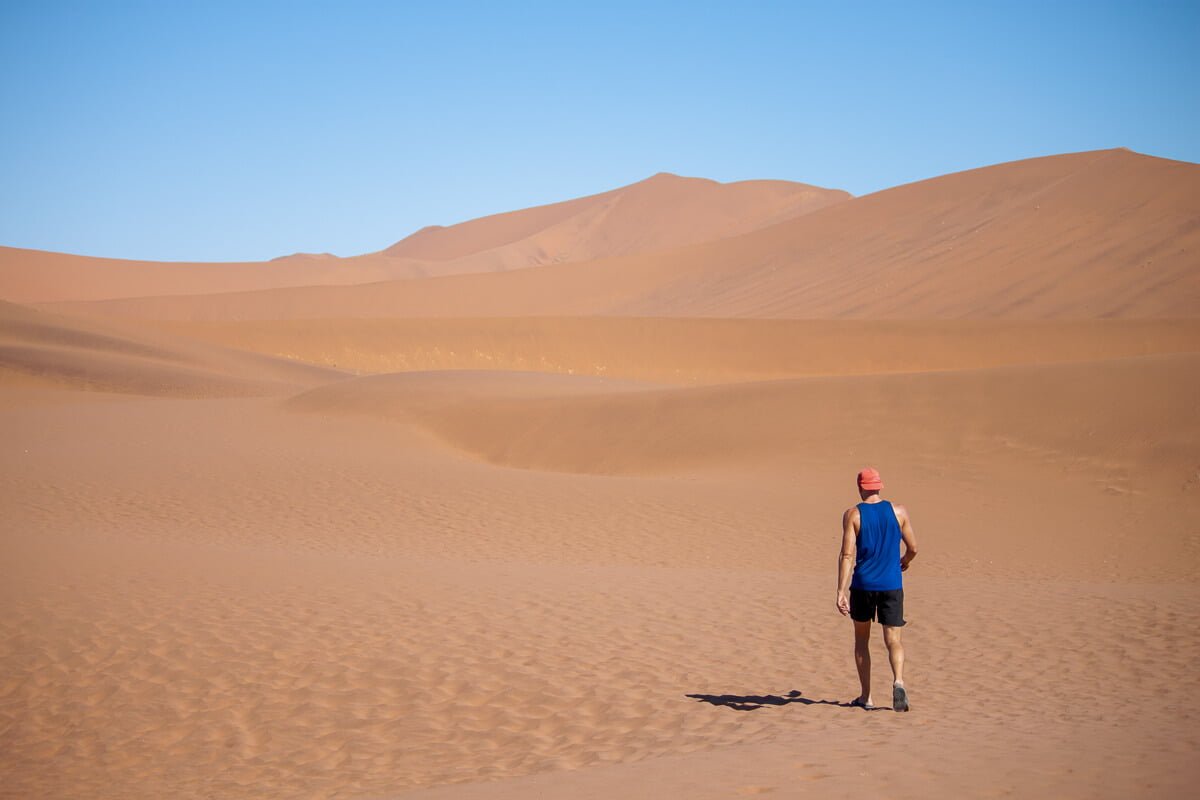Too Un-baa-leivable to Be True?
I'm merino mad. I love wearing merino wool and constantly spill yarns about it to convince others to wear it too.
But, I'll sheepishly admit that I sometimes exaggerate. Here's my confession:
Merino isn't perfect.
If it were, I'd wear nothing else. But I wear plenty of non-merino apparel too. And most of the merino clothes I rave about aren't even 100% merino.
So, instead of trying to pull to wool over your eyes or fleece you, here are the honest benefits and disadvantages of merino wool, how it compares to other fabrics, and my favorite merino apparel.
In This Merino Wool Review:
Merino Wool's Benefits and Disadvantages

✓ Merino's Wearable Styrofoam
You know how styrofoam cups keep hot drinks like coffee hot and cold drinks like iced tea cold?
Well, merino does the same for you when you wear clothing made of it. It keeps you cool when it's hot and warm when it's cold.
And if the styrofoam analogy doesn't convince you of merino's insulating incredibleness, consider Shrek.
Shrek was a renegade. He's a merino sheep who avoided being sheered for six years and, since merino sheep's wool doesn't stop growing, become a giant cotton ball with legs.
If his 60-pound (!) coat were made of any other material, he'd be toast. But because it's merino, he stayed cool in New Zealand's hot summers.
✗ Merino's Not as Soft as They Say
The people who try to tell you merino wool is super soft are probably the same ones who tell you so-and-so veggie burger tastes exactly like real beef.
Merino definitely ain't silk. It's not even cotton. That's why you're not going to be sleeping under merino wool sheets at the Ritz any time soon.
But it's not scratchy like regular wool, either.
Here's the truth:
Sometimes, when I initially put on a merino wool garment, I think, "Hmm, this isn't that soft." But that thought doesn't cross my mind after that. I don't think about my clothes at all because it's so magically insulating.
✓ Merino Is Deodorant
Even when I fart the faintest of farts, Kim's super-sensitive sense of smell can detect it from across the room. It's annoying.
But she can't detect when I'm wearing a merino t-shirt for the 10th time without washing it. Somehow, the antibacterial properties of the fabric destroy odors.
Watch the above video if you don't believe me. This guy wore the same Wool & Prince merino dress shirt for 100 days without washing and people couldn't tell.

✗ Merino's Not Invincible
I honestly and respectfully disagree with all the other blog posts out there that claim durability to be one of the benefits of merino wool.
Sure, it's more durable than the wool sweater your granny knit for you but it isn't durable compared to whatever you're wearing now.
You won't see many merino wool pants or sports apparel on the market and you will see a lot of holes in merino shirts' elbows because it's not that stretchy and eventually breaks.
So while it's easily durable enough to machine wash (every 100 days or so you have to do so), you definitely shouldn't put any merino in the dryer.
✓ Merino Doesn't Wrinkle
If you've seen my packing list and best travel tips, you know I don't believe in folding clothes and hope to never touch an iron again in my life.
With merino, I'm assured of avoiding both because the stuff doesn't wrinkle.
I'm going to wrinkle before my merino clothes do.
✗ Merino's Plain
Aside from some pretty spiffy dress shirts (at least I think they're spiffy), most merino wool clothing is plain, practical type attire.
"Unstylish," some would say.
Kim's one of them. She doesn't wear merino simply because she hasn't found anything that looks good enough for her.
Apparently, merino doesn't have the versatility of other fabrics and that fashion designers desire to transform it into impractical but stylish designs.

✓ Merino's Thirsty
Merino can absorb as much as 30% of its weight without feeling wet, making it the most "hydrophilic" of all-natural fibers.
Generally, that's a good thing because it absorbs your sweat or the rain to keep the fabric clinging to your skin. It gives your skin the room to do its job of regulating your body temperature.

✗ Merino Doesn't Give Up Moisture Easily
Hydrophilic is Latin for water-loving so, just like if you gave me a beer you'd going to have a hard time getting it back, it takes a while for merino to give up the water it absorbs.
These guys found that a 100% merino wool shirt took 40% longer to dry than a 100% polyester one. (48 minutes vs. 34.)
They also found that an 87% merino, 13% nylon Icebreaker Tech T lite dried just as fast (34 minutes). But I have a hard time believing that.
I often wash and dry my merino wool tank alongside synthetic ones and it always takes longer to dry.
✓ Merino's Easy-Care for Mother Nature, Too
Synthetic fabrics take 20 to 200 years to biodegrade and are polluting our waterways worse than you'd expect.
All-natural merino takes just six months. Watch the above video to see.
So whenever the sad day comes that you have to say goodbye to your trusty merino wool clothing, you can at least take solace in the fact that it's not going to harm the planet.
✗ Sheep Might Not Appreciate Us Stealing Their Coats
Shrek probably hid from shearing for six years for a reason.
And if you look online, you'll find horror stories of farmers treating their sheep poorly and learn all about of "mulesing."
"Mulesing," to save you from Googling it yourself and seeing the graphic photos, is the removal of large swaths of skin and flesh from the area around the anus of a sheep. Sheep farmers do it to combat a blowfly infestation called "flystrike," which sometimes afflicts the unnaturally dense, urine- and feces-encrusted skin folds around their animals' rear ends.
Some farmers have abandoned mulesing for other flystrike prevention techniques. Others do it because it works and is good for the sheep.
And most merino brands say they take caution to only work with ethical farmers.
It's up to you to form your own opinion on whether this is a disadvantage of merino or not.
✓ Merino Keeps the Dirt Off My Shoulder
One final magical benefit of merino wool is that it is naturally anti-static.
I didn't know this until doing research for this post, but static attracts lint and dirt and other tarnishes.
That explains why, in addition to its odor- and wrinkle-lessness, I can wear merino so many days on end without having to clean it.
✗ Merino Takes a Lot of Money out of My Pocket
You may get a bit of sticker shock when you see the prices of my favorite merino wool clothes.
I think they were worth the investment. You may not.
Merino Wool vs. Other Fabrics

Merino vs. Synthetics
Low-quality synthetic shirts start stinking as soon as you look at them, stain easily, and don't insulate, but they're more stretchy and durable than wool.
Higher quality synthetics do a better job at negating the downsides. Prior to getting into merino, I was all about Lululemon's shirts. I still have some and wear them regularly. But they cost the same as merino.
Merino vs. Cotton
Cotton's definitely softer, cheaper, and more versatile from a style standpoint, but it's worse for any type of activity because it gets heavier, stinkier, and dirtier faster.
Merino vs. Wool
Merino should have taken a lesson from alpaca and cashmere and completely dropped the word "wool" from its name.
"Wool" brings back mostly negative memories of having to wear unpleasantly scratchy clothes to cope with even more unpleasant weather. And it always had holes in it.
Merino's fibers are finer, which makes it softer, and longer, which makes it stronger.

Merino vs More Exotic Furs
Speaking of cashmere and alpaca, there are plenty of other animal furs like mohair, angora, and camel that are less popular than merino but may have some potential as technical clothing.
Alpaca, in particular, seems to be gaining some steam as a merino alternative.
Arms of Andes is one of the companies making the push. They read this post, contacted me to say, "You think merino's hot stuff? Try alpaca," then stuck their neck out (you know, because alpacas have long necks) by sending me a 100% alpaca base layer to prove it.
My opinion after two months of heavy use:
- Looks and feel is closer to cashmere than technical merino.
- Super warm. Despite being thin (230 GSM), I get by with just it in 10°C/50°F. No wonder alpacas stay warm way up in the Andes.
- At least as dirt and smell resistant as merino. Despite wearing it for workouts and beach volleyball all through the fall, Kim hasn't smelled it and said, "Eww, gross. You have to wash that," yet.
- TBD on durability and how it'll hold up now that we've relocated from rainy, cold Vancouver to warm, dry Cape Town.
So alpaca's truly hot stuff. I'll see how cool it is over these next few months. What's definitely cool is the Arms of Andes founders' story and mission. It's worth checking out.

Merino vs. Nothing
The best fabric is no fabric at all.
Or just a pair of my favorite comfy merino shorts if I have to. That's why Kim and I live in places like Medellin and Cape Town during the northern hemisphere's winter.
But wearing nothing's not perfect, either. No matter hairy I get, body hair's horrible at insulating. And it's generally frowned-upon to walk around over-exposed.
Merino with Other Fabrics!
Some companies are messing with nature and combing Merino for super fancy, technical fabrics. Many of my favorite products are made this way.
Let me tell you about some of them now.
Great Merino Gear
I want your first merino experience to be as good for you as it was for me, so start slow and start with the best.
Try with one of the following merino wool products and, if you like it, start going crazy.

Wool&Prince Wool-Linen Button Down
This short-sleeved Wool & Prince button-down shirt is from the guy in the video above who wore the same shirt for 100 days.
I'm still working it in but it's already become my go-to for travel (the chest pocket's key for boarding passes and passports and the no-stink's a relief to people sitting by me) and for going out for tapas here in sweltering, summer Spain.
Because it's half linen, it gets more wrinkly than 100% merino clothes, but I don't mind. It gives the shirt a less preppy and more casual look.

Outlier Ultrafine Merino Tee
Remember when I wrote above that merino's not as soft as they say? Well, I wrote that before Outlier sent me their Ultrafine Merino t-shirt. The shirt very nearly feels like soft cotton but acts like merino (no smell, wrinkles, etc.).
Just like Outlier's shorts, it didn't wow me out the box, but won me over the more I wore it. It has now taken the title of favorite t-shirt from my Icebreaker Cool-Lite Sphere merino shirts. I just wish I'd picked a better color.
The only thing that holds me back from declaring it as a must-buy for first-time merino wool wearers is that it's as crazy expensive as it's crazy good. Maybe ask for one for your birthday.
Or, for a great merino t-shirt that's almost as good as Outliers and not quite as expensive, consider getting one from Unbound. (Outlier and Unbound…basically the same name, too!) I have a charcoal gray one and would definitely buy another if I lost it.

Icebreaker Cool-Lite Momentum Shorts
It's funny that they call these shorts "Momentum" ($90) because I basically only wear them when sitting around at home.
I rarely wear them out of the house because Kim says they're not suitable for the public, but the first thing I do when I get home is put them on.
Darn Tough Athletic Socks
Darn Tough is a great name and these socks live up to it. They're guaranteed for life.
Get a pair and try this challenge:
Wear them for a workout, let them dry out, and give them a whiff.
Wool-d You Give it a Chance?
Hopefully I've convinced you that merino wool's benefits far outweigh its disadvantages.
If not, maybe this shameless merino wool propaganda video I made, in which I travel back in time ten years to illuminate my naive younger self, will win you over:




I just wanted to add that the only socks I use are made with either 100% Merino wool or are a blend. My feet get so sweaty and I very easily break out in athletes foot and get super stinky feet if I wear anything else. Ever since I started wearing only Merino socks I haven't had an athletes foot outbreak and my shoes don't stink. When I tell people I wear Merino wool socks, they're like that's so hot though. Give it a try!
Whoa… you're totally right, valB! I too sometimes get athlete's foot breakouts, but not for a couple years now, which coincides with when I started wearing merino wool socks. I never put two and two together until you mentioned it. I'll add this point under the Darn Tough socks recommendation. Thanks!
Wanted to clarify. People say they're hot, but they're not necessarily. Depends on the thickness. They're thinking of traditional wool.
I love merino! Im obsessed with all the 100% extra fine merino clothes of Uniqlo that I bought about $500 worth of clothes during their winter sale lol. I find Uniqlo’s merino is the best quality at the most unbeatable prices. I Live in Texas and our weather is bipolar. So when it gets a bit warmer i dont worry about sweating as long as i wear my merino clothes. Love love!
I didn't know Uniqlo makes merino apparel. Thanks Cristy! The Uniqlo EZY jeans (jeans that feel like sweatpants) are awesome, so I'll have to try some of their merino stuff to see if it's just as good. Prices seem reasonable, especially for merino, too.
I am just now introducing myself to Merino, so far I'm in love with it. I appreciate you pro/con comments and will continue searching and wearing Merino. If I had not been to a Merino outlet in New Zealand I would have missed this awesome material.
I wish you a long, healthy, loving, odor-free relationship, Jean!
You forgot one thing on your list of pros and cons. Merino is subject to moth holes just like any other wool. Especially if you go a long time between washings, because moth larvae are attracted to skin flakes and food stains. My favorite merino T shirt got a moth hole over the winter—but I wear it anyway! And my superfine T shirt dries just as quickly on a hanger as a cotton one does in the dryer.
Good point, Conwegian! I've added moth holes to the disadvantages of merino. Thanks!
Farm to Feet merino wool socks were my in to merino. Same unconditional lifetime warranty as Darn Tough. Try the farm to feet Denali socks, as they have 91% merino wool.
Cool. I'll have to get myself a pair to compare to the Darn Toughs. Good timing too, because my Icebreaker socks are wearing out so I need replacements. Thanks Pete.
I make felted wearable items out of merino. I could never wear wool but merino does not feel itchy to my skin.
Try felting, but beware, it's addictive!!!
I've loved Merino ever since I got my first sweater in it when I was ten. Plus, wool is great for cloth diapering, so I'm looking forward to using it for that! My biggest problem is socks. I'm desparately in search of wool toe socks because I just can't stand my toes touching, but they're impossible to find!
Wool diapers? Huh. Something to keep in mind. Thanks.
I've never noticed my toes touching before. You must have exquisitely sensitive toes. Maybe get toe spacers until merino toe socks hit the market?
One thing to consider is that there are apparently people who find ANY wool itchy. I know because I am one of them. I kept seeing all these ads form all these companies selling Merino clothing, claiming it was non-itchy, keeps you cool in summer, blah, blah, blah. I finally caved and ordered a t-shirt from Woolx. Maybe Woolx is not really a good brand (?), but in any case I was very disappointed. Simply put, it was itchy. Not as itchy as other types of wool, but still bad enough. I simply cannot abide that awful crawling, prickling sensation on my skin. Adding to the disappointment was the fact that the shirt was VERY thin, to the point of being fairly see-through. Perhaps both problems could have been solved by wearing another shirt of a different material under the wool shirt, but their whole advertising campaign is built on the promise that you don't have to. I would also have been very worried about durability in such a thin shirt. Needless to say, the shirt went back. I have decided that the ultimate hot weather fiber is linen, which you do not even mention. Linen is naturally antimicrobial, quicker drying than cotton, totally non-itchy, and–if good quality fabric has been used–very durable. I am just now having to replace my grandmother's linen dish towels that I have used for the past thirty years, and which were already well used when I got them.
Hi Laurie,
Kim feels the same way as you. She too can't stand the feel of merino on her skin and is infatuated with linen. Linen may be antimicrobial, but in my experience it stinks up faster than merino and I can't stand the wrinkles. (Or , better said, Kim can't stand them on my shirts and doesn't let me wear them unless they're flattened out.)
As for WoolX, I don't have experience with their products but suspect they're closer in quality to Icebreaker (ok for some, not for all) than to Outlier, Unbound, or Core Merino. If you're ever open to trying more merino and have money to burn, give those brands a try.
Interesting comments regarding itch. The softness of wool relates to the fibre diameter. Ultrafine wool can be as low as 9 or 10 microns. From memory Icebreaker is in the 18-19 micron range. Some others are 17 microns. One manufacturer has the finest production wool apparel I know of at 16microns and it feels much silkier than even cotton. There is a machine to measure fabric softness and at 16 microns wool is 30% softer than cashmere. This was also backed up with human trails. Basically the finer the micron the softer the product. Cheap blended product with broader fibres (greater than 19 micron) will cause some irritation depending on an individuals sensitivity. Trials done on extremely sensitive dermatitis sufferers found that at very low microns not only did they experience no discomfort but their dermatitis cleared up. The researchers described it as akin to a medical breakthrough. I have not seen product at the 13 and 14 micron range but it would be "otherworldly". Thanks for your story on Merino.
I haven't bought any yet what about there long underwear for the cold months I get cold very easy been thinking about purchasing some what's ur opinion on this garment
Hi Michael. I don't have experience with merino long underwear, but I think it's a great idea in your case. You wouldn't have to wash it as often and, as I wrote, it does an excellent job at insulating. Give it a shot and let us know how it goes!
Wear what you want when you want. Your GF doesn’t have the right to tell you how to dress. Equality would mean that you could tell her what and how to dress. We all know that’d go over like a lead balloon.
"Go over like a lead balloon." I like that! And I'm with you on wearing what I want. Mostly. It also helps to have a second opinion, though, if I care at all how I look, which happens sometimes. And she cares how she looks, too, and actually sometimes listens to my feedback too. Probably because I listen to her.
I'm working out outside in 35 degrees every day and I'm a sweaty Betty. Before buying my first wool top I would spend hours after exercising freezing cold as my sweat was cold sticky and slimy and I cant shower for a few hours. This wool top is amazing! Never to hot or cold and I am so dry. You non sweating people live the life! It's amazing to be dry and warm. Does merino really work so well in the summer in the 100s? Cant wait to find out!
Wow, you must work hard to be a sweaty Betty in 35°F weather! And yeah, merino's great at absorbing sweat as long as you don't get too sweaty. Once it's fully saturated, it takes longer to dry than synthetics. Worth noting for you, because if you're sweating at 35°F, I imagine saturation will come fast at 100°F. But I don't think there's any fabric that can safe you at that point.
It's interesting to learn that merino wool is anti-static naturally. I'm thinking of getting my brother a merino wool shirt for his birthday in the coming weeks. I'll have to find a nice one that fits his style so he'll like it.
Based on my experience, you get what you pay for. Outlier, Core Merino, Wool&Prince, and Unbound tees are much better (and better looking) than Icebreaker ones.
I'm super curious about the wool/linen fabric! Does it make like a super fabric? Seems like it would have all the best effects of both and cancel out any negatives. Plus be super durable.
Hey Tia. Durability has certainly been a major plus. And the anti-smell/stink is just as good as pure merino. The biggest downside from my experience is the texture. It's not nearly as soft as good-quality merino. Because of it, Kim gave hers away. But she's finicky. For me, it's not a dealbreaker and my wool-linen T remains my go-to "fancy shirt."
I tried merino socks, and in hot weather I ended up with a rash around my ankles. Disappeared when I gave my socks to my sister. I might still be willing to give it another shot in cold weather, but wearing wool next to your skin might not be for everyone.
Thanks for sharing, Eliza. If wool next to your skin was the issue, why do you think the rash was only around your ankles and not the rest of your feet, too?
You write: "That’s why you’re not going to see merino wool towels hit the market any time soon."
But that is NOT the reason!! the reason is that keratin (the substance of wool fibers) DOES NOT WICK -it will absorb internally (but that is NOT wicking). Wicking is the capillary transport of water/liquid which is due to the SURFACE ENERGY if the substance. Wool has a phospholipid structure where the hydrophilic (water absorbing) ends are inside the microfibrils while outside the hydrophobic (water repelling) ends are on the outside so water will just run off wool clothing (especially if it is rather tightly woven/knitted). Cotton, linen, hemp etc. vegetable fibers as well as the reconstituted fibers such as Rayon, viscose etc. are made of cellulose which not only does wick but does absorb moisture too making those fibers great for towels and soaking up water.
I suggest you learn about the chemistry behind all the properties of the fibers you write about.
Thanks Gregor.
I'd like to understand what you're saying better. So the exterior of merino fibers is water repellant but the interior is water absorbing? How does the water get in then so that it can famously absorb up to 35% of its weight in water, then? I tried very quickly looking it up and found this diagram from Icebreaker to be somewhat helpful.
Also, you're right that towels were a bad example to use when I wanted to emphasize how merino's not as soft as other fabrics, so I've changed the example to sheets. Thanks for pointing that out.
I agree it's probably a matter of bad terminology:
Wool may not wick (=allow for capillary action) (I'm not sure that's the case though), but is said to be good at *wicking-away* (move from the inside to the outside of the fabric) moisture.
Cotton on the other hand wick very well (=allow for capillary action) but is said not to be good at *wicking-away* (it just remains damp).
I think it would be better if the term "wicking-away" (often used by the sellers of the products) were replaced with another term.
Does anyone know why a lot of merino tops tend to be staticky?
I had never experienced wool as staticky until I wore merino tops, which was pretty annoying. The tops I have can be more staticky than some synthetics.
I came across a possible reason after years of trying to find out: is merino thread MERCERISED (which I think means coated) with something that causes this static and which would also therefore cover up the actual thread in a way that you might as well be wearing some other yarn?
I daresay the best merino garments are 100% natural – but how do you know until you've worn them?
Hey Anna. Which brands have you tried? I've never experienced static before.
Wool/cotton fabrics are very skinny. In terms of hygroscopic perspiration, I think they have the same effect. Some partners think wool fabrics are tickling. It's depending on the sensitivity of everyone's skin. You can try 100% ultra -fine merino wool fabric. Its effect is more comfortable than some wool blended.
I love wool and I dislike how Merino is used for EVERYTHING because it can give all wool a bad rap when it is asked to perform a function for which it is poorly suited.
Merino is a fine wool, the finest sheep wool, although *even Merino comes in different grades of fineness*, which contributes to feeling soft. Other sheep breeds provide fine wool and many finewool breeds were created using Merino. However…Merino felts (unless acid treated aka Superwash), can pill, and is not suited for fabrics that will take much abrasion and need to be harder wearing.
– Other finewools exist, monoculture in farming is generally considered a bad thing, so where is my Cormo, Targhee, and Romeldale?
– Alpaca is warmer and softer than Merino, but has no spring, so it tends to get out of shape – hence why you see (yarn) blends of Alpaca and Merino
– Suffolk, Southdown and other Down breeds have more spring and are harder to felt, so they make good sweaters and socks but are more 'prickly'
– For a real hard wearing sheep's wool for upholstery or carpet, you'll probably want Drysdale or another Longwool
– Many of the Longwools have more shine to the fiber, so they have a nice sheen. I've often thought a nice barn coat would be something made of Lincoln Longwool (shiny!) but lined where it might touch skin (cuffs, neck)
Stumbled across this article and it set me off on this little rant, which I hope someone finds interesting in the future!
Thanks for your intro to the wide world of wool! (The Wool-d?) I'd love to expand my horizons beyond merino and will be on the lookout.
Love the woolly Shrek in your story! But I was simply wondering how to get rid of tiny residue flakes of skin or soap on the inside of my black extra fine Italian Merino wool turtleneck which I so comfy all winter. I used a lint brush & it helped a little. I'm not sure if the residue is soap or skin, or both. Would vinegar or lemon work? How do I avoid the residue?
Thank you for your time!
Zita-D. (Quebec, Canada)
Hi Zita-D. Sounds like a nice turtleneck! Sorry to say, I can't help you because I have nothing so fine that can't be machine washed. Anyone else reading, please share your suggestions.
1. I so wish the claims about merino not stinking were true! My tops get super stinky under the arm, and no amount of airing can get it out. I’ve tried to find ways to remove the smell without washing the shirt (eg. sprinkling with baking soda and leaving it for a day), but nothing helps. Any advice?
2. On the other hand, I do find thin merino to air dry fast enough.
3. It’s definitely way more comfortable as underwear than cotton. In my experience, cotton holds on to all the moisture, traps you in and weighs you down. Merino somehow seems to air out almost as fast as it absorbs the moisture.
4. It also doesn’t feel cold like cotton on your sweaty back.
5. I had my kids in cloth nappies with wool covers, and it was great. And there’s so many options! You get the best-thing-ever thick felted interlock pants (with 5% elastane though) that are so durable they can last your child 4 years or more, and will protect them from wet surfaces and sharp pebbles, and I don’t see why they don’t exist for adults! You get the double layer traditional knit type ones I used for night-time. And then there’s also super thin summer ones for around the house, etc. Ruffles, skirts added on, whatever you fancy.
6. I also so wanted linen to be the solution for scorching days, but I always felt really stuffy even in very loose linen clothes.
Hi ES. Thanks for sharing your experience with merino! Could it be that your shirt's too tight to your armpit? From my experience, a shirt of any material will stink if it's pretty much strangling your pits.
Do you know if merino dries out hair? I can't find a consensus. My merino buff is my go to after a hood but I'm concerned I'm damaging my hair further